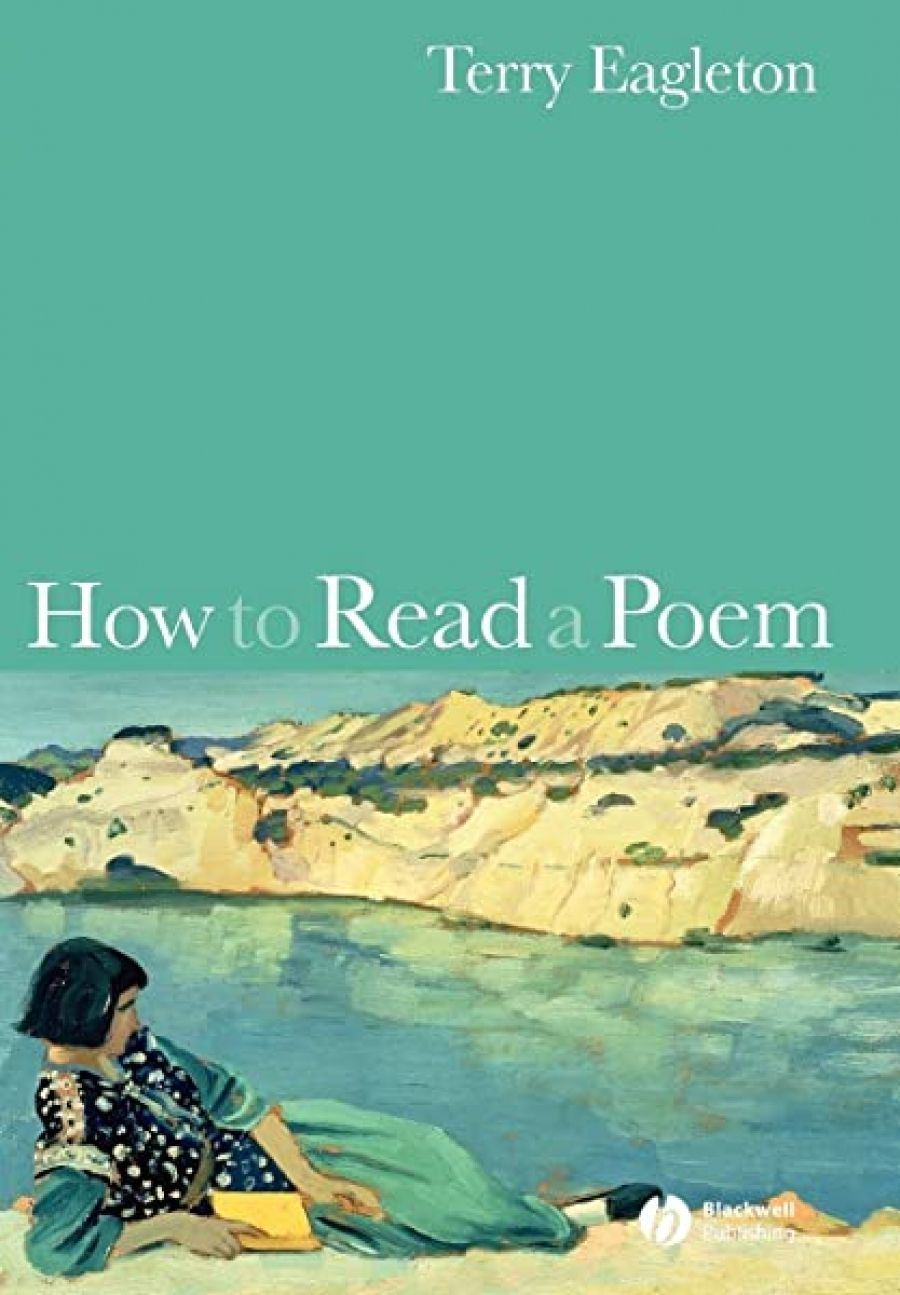
- Free Article: No
- Contents Category: Poetry
- Review Article: Yes
- Online Only: No
- Custom Highlight Text:
The English critic Terry Eagleton is nothing if not a dasher. Once suspected by many as the kind of postmodern theorist who undermined the category of ‘literature’, he has increasingly hiked into its territory. In The Illusions of Postmodernism (1996), he turned against the kinds of scepticism and virtuality which he saw as demeaning all literary or cultural study. The book certainly made some of his former allies quite cross, not least because it was penned with such rhetorical high spirits. His Marxist foundations, sturdily nourished in a Salford boyhood, remained, however, and were built upon. Yet they are sometimes twinned with residues of Catholic belief, as his recent attack on the atheism of Richard Dawkins has shown, full as it is of residual theology. He can certainly be an odd kettle of fish. In How to Read a Poem, Eagleton takes a broad brush. He remains at home with the traditional texts, the kinds of poems we have long deemed important.
- Book 1 Title: How to Read A Poem
- Book 1 Biblio: Blackwell, $27.50 pb, 191 pp
- Book 1 Readings Link: booktopia.kh4ffx.net/4eG2xG
At Eagleton’s heart here is a warm place for that kind of tradition to which Walter Benjamin paid tribute:
Experience for Benjamin meant the stories which the old recount to the young; and its disintegration in modern times was in his eyes one of the most grievous forms of modern poverty. In a world of fleeting perceptions and instantly consumable events, nothing stays still long enough to lay down those deep memory traces on which genuine experience depends.
This is a crucial piece of tribute, laying clear for us that the status of our experience lies at the core of what the mercurial Eagleton is after, what he yearns to preserve.
Yet as we move into these fluently concise pages, we may well suspect that Eagleton is a kind of modern Santa Claus, trying to cram all manner of things into our stocking. Early on, he says very finely that literary criticism is ‘a sensitivity to the thickness and intricacy of the medium which makes us what we are’. At this point, we can surely feel his closeness to Leavis, or to Empson; but he swiftly skates on into the modern death of experience, the loss of who we really are, and thence to the throbbing core question, ‘What is poetry?’
As its title, How to Read a Poem, plainly suggests, this is a work aimed at the senior high-school student or the young undergraduate (probably a reason why the price has been kept so modest). Accordingly, and with due propriety, Eagleton does his general topics first, one after another. Once he has Form pretty much in place, he steps forward through the local categories of practical criticism: through meaning, tone and pace, down to rhyme, rhythm and imagery. It is delightful also to see his remark that ‘One of the most neglected formal techniques is punctuation’ soon followed by melancholy wit in the complaint, ‘Colons, incidentally, have almost passed out of existence, along with string vests and sideburns’.
Yes, Eagleton can be funny, but he is also a subtle close-reader of the poems which he holds up for examination. There is, for instance, a beautifully done rhythmic reading of Ralegh’s ‘Walsinghame’ and Stevie Smith’s quasi-daggy ‘Not Waving But Drowning’; this could be exemplary for students trying to analyse aural effects. And he turns up with some masterly rhetorical analyses of passages from Yeats, whose Irishness no doubt appeals, even though his excesses appal the critic. There is also a wickedly funny reading of a stanza from Tennyson’s ‘Mariana’.
In Eagleton the persuasive critic, there is a Romantic-modernist poet struggling to get out: not drowning, but waving. From time to time, he releases the odd Wildean sentence such as ‘Serial killers may indulge in unspeakable flights of fancy’. What is more, at the opening of one chapter he quotes an old chunk of his own Shakespearean parody, only to disclaim it with nervous irony.
Having come from the Cambridge which held both Leavis and Raymond Williams, Eagleton goes in search of ways to mesh close reading with social and historical responsibility; indeed, Leavisism quite often went along with Marxism. In passing, I should add that the Russian formalists bob up as heroes here, especially Yuri Lotman.
The book ends with extended analyses of four nature poems, accounts in which the political critic blends with the intense reader of verse. Exemplary of Eagleton’s final approach is his brief account of the iambic pentameter measure as being ‘a triumph of reconciliation between order and freedom, necessity and spontaneity, the rulegoverned and the open-ended … it allows for just the kind of balance between the individual and the social order which liberal societies tend to favour’.
In this highly readable study of poetry and criticism, a passage of this kind gives us the best brief picture of Terry Eagleton’s strenuously held position. Overly masculine though it is, How to Read a Poem should do well here, especially among those who have never heard of Lotman.


Comments powered by CComment